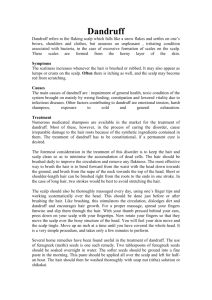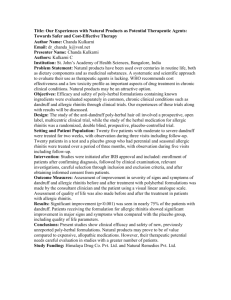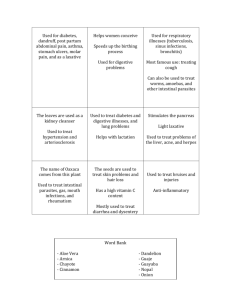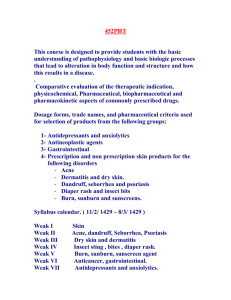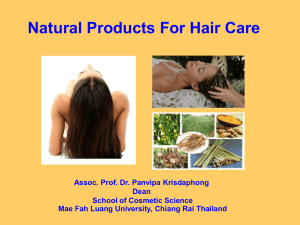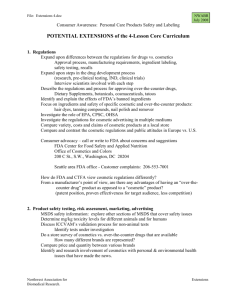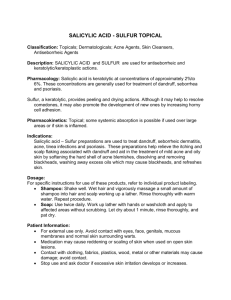Resident Microbial Flora of the Human Scalp and Its
advertisement
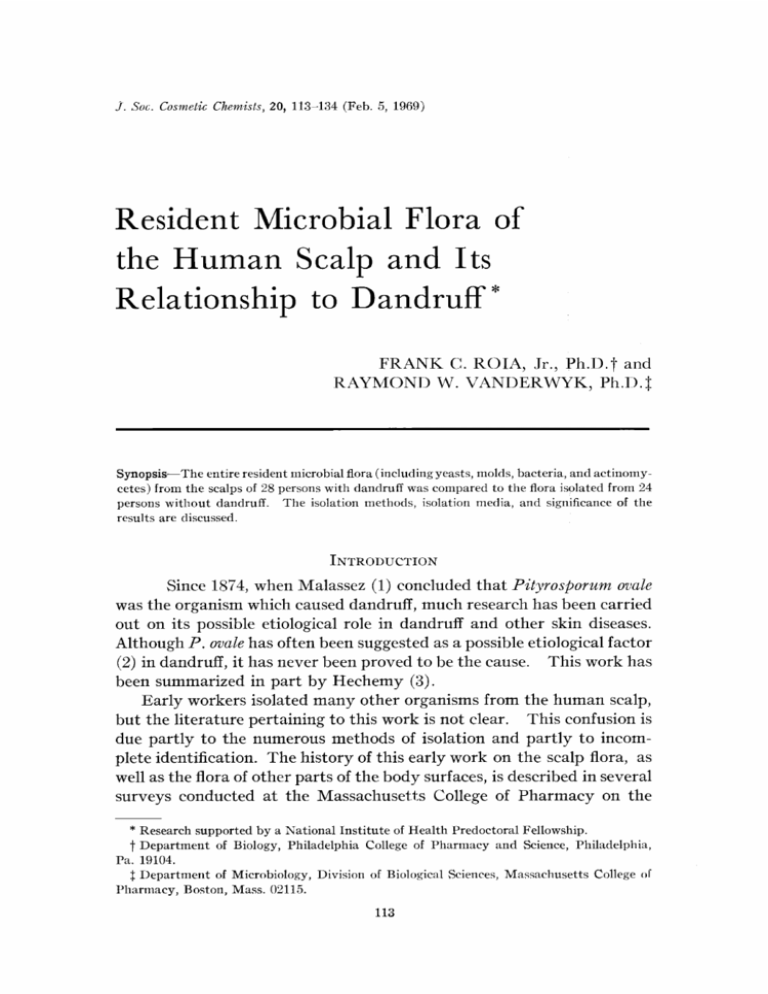
J. Soc. UosmeticUhemists,20, 113-134 (Feb. 5, 1969)
Resident
Microbial
Flora
of
the Human Scalp and its
Relationshipto Dandruff*
FRANK
RAYMOND
C. ROIA,
Jr., Ph.D.p and
W. VANDERWYK,
Ph.I).{
Synopsis--The entire residentmicrobialflora (includingyeasts,molds,bacteria, and actinomycetes) from the scalpsof 28 personswith dandruff was comparedto the flora isolatedfrom 24
personswithout dandruff. The isolation methods, isolation media, and significanceof the
results
are discussed.
INTRODUCTION
Since 1874, when Malassez (1) concludedthat Pityrosporum ovale
was the organismwhich causeddandruff, much researchhas been carried
out on its possibleetioloõicalrole in dandruff and other skin diseases.
Although P. ovalehas often been suggestedas a possibleetiologicalfactor
(2) in dandruff, it has never been proved to be the cause. This work has
been summarizedin part by Hechemy (3).
Early workers isolatedmany other organismsfrom the human scalp,
but the literature pertaining to this work is not clear. This confusionis
due partly to the numerousmethods of isolation and partly to incomplete identification. The history of this early work on the scalp flora, as
well as the flora of other parts of the body surfaces,is describedin several
surveys conductedat the MassachusettsCollege of Pharmacy on the
* Research supported by a National Institute of Health Predoctoral Fellowship.
t Department of Biology, Philadelphia College of Pharmacy and Science,Philadelphia,
Pa.
19104.
:• Department of Microbiology, Division of Biological Sciences,MassachusettsCollege of
Pharmacy, Boston, Mass. 02115.
113
114
JOURNAL OF THE SOCIETY
OF COSMETIC
CHEMISTS
microbial flora of the human scalp (4-7). These surveysshowthat the
scalpharborsyeasts,molds,and bacteriain great abundance.
In all the surveysscurf was obtained by brushingthe scalpwith a
sterile brush or comb and allowing it to fall upon the surfaceof enriched
complexorganicmedia consideredto be best suitedfor the growth of the
particulargroupof microorganisms
that wasbeingisolated. No distinction was made betweenthe presenceof the residentand the nonresident
microbial flora. The resident flora includes those organismswhich are
capableof living on the scalpby utilizing the nutrientsavailablethere.
The transient flora includes microorganismswhich do not subsiston the
scalp,but are presentastemporarycontaminantsfrom the air and soil.
No attempt wasmadeto correlatethe degreeof dandruffformationwith
the specificorganismsisolated,nor was any considerationgiven to the
scalp conditionand type of groomingaid, nor to the interval of time
between the last shampooor dandruff treatment and the time of sam-
pling. The purposeof thesesurveyswasto obtainknowledgeaboutthe
microbial flora of a random group of "normal" subjectsin order to establish a basis for future researchon the possiblemicrobial etiology to dandruff.
In 1964,VanderWyk and Roia (8) showeda relationshipbetweenthe
severityof dandruffand the presenceof microorganisms
on the human
scalp. The application of broad spectrumantimicrobial agentseliminated almostcompletelythe microbialflora, and this resultedin a significant decreasein the amount of scalp desquamation.
More recently,VanderWykand Hechemy(9) carriedout a half-head
experimentand showedthat nystatin-sensitive
yeasts,including_P.ovale,
had a greater influenceupon dandruffproductionthan did thoseorganisms,principallybacteria,whichweresusceptible
to tetracycline.
Van Buskirk (10), usinga HairVac technique(8) for obtainingscurf
samplesand complexorganicmedia for isolatingaerobicbacteria, suggestedthat a relationshipexistedbetweenthe productionof scurfandthe
number of bacteria present. However, he made no attempt to establish
a causeand effect relationship.
Many other etiologicalfactorshave been associatedwith this scalp
Due to
the provedeffectiveness
of antibioticsin scurfreduction,it would seem
condition, and these have been summarized by Lubowe (ll).
that the influence of microorganisms is one of the more important con-
tributing factorsin excessivescalpdesquamation.
The purposeof this researchwas to find out if any specificmicroorganismor group of microorganismscould be definitely linked to dan-
druff production.
FLORA
OF
SCALP
AND
DANDRUFF
115
QUESTIONNAIRE
Age
Sex
1. Please circle one:
Do you have a dandruff problem?
Yes
No
(If your answer is Yes, answer questions 2, 4, 5;
if your answer is No, answer questions 3, 4, 5.)
2. Please
circle
one:
Would you consider your dandruff problem
Severe
3.
Please
a.
circle
I have
moderate
mild
one:
no dandruff
b. I have occasionally slight dandruff
c. I have slight dandruff
4. Please circle one:
a. Do you use a dandruff preparation?
Yes
No
b. If your answer to 4a is Yes, please name the preparation(s).
5. Please circle one:
a. I would
like to be a volunteer.
Yes
No
b. If your answer to 5a is Yes, please give name.
Figure 1.
Questionnaire presented to the five undergraduate classes at the Massachusetts
College of Pharmacy
MATERIALS
AND METHODS
Selectionof Subjects
Fifty-two subjects, including two females, with varying degreesof
dandruff were selectedfor study. These subjectsranged in age from 18
to 49 years. Those between 18 and 23 years of age predominated. A
personwasnot selectedif he showedobvioussignsof baldnessor if he had
a history of psoriasisor other scalpdisorder. Volunteerswho developed
redness or showed signs of irritation on the scalp during the sampling
period were eliminatedfrom further study. Personswith dandruff were
kept under observation without their knowledge for several days.
Those that showedvisible signsof scalp scalingand who obviously had a
problem of dandruff were askedto be volunteers.
This method of selection was impractical to use in obtaining volunteerswithout a dandruffproblembecausethe absenceof visible scurfdoes
not necessarilymean the absenceof a dandruff problem. It more likely
indicatesa temporary cessationof exfoliation due to the judicioususe of
an antidandruffproduct. Thosesubjectswith no dandruffproblemwere
selectedby their answersto a seriesof questions(Fig. 1). This ques-
JOURNAL
116
OF THE SOCIETY
OF COSMETIC
CHEMISTS
tionnaire was presentedto all five undergraduate classesof the MassachusettsCollegeof Pharmacy. The meaning of each questionwas carefully explained to all participants. When possiblethose personswho
answered, "I have no dandruff" or "I have occasionallyslight dandruff"
were chosenif they were not in the habit of usingan antidandruffpreparation.
The questionnairehelped to obtain subjectsand to substantiatethe
occurrenceof dandruff. Since this was a survey based on personalobservationsand opinions,the interpretation of theseresultsmust be made
with that in mind.
Collectionof Sc•trf Samples
J>resamplingPeriod--Before scurf samples were taken, a precise
regimenwas followed by all volunteers (Fig. 2).
INSTRUCTIONS
It was obviousthat
TO VOLUNTEERS
This experiment will take two weeks. Directions are simple and not much will be required
of you, but it is very important that all instructions be followed faithfully. I cannot do any
research without your help.
FIRST
WEEK:
I sincerely thank you for your assistanceand cooperation.
(Presampling Period)
Day One:
1. Shampoo hair THOROUGHLY
2. Rinse
VERY
WELL
with
with « oz. of Breck Normal Shampoo.*
water.
3. Use ONLY WATER to comb hair and to kecp in place.
(Use comb given to you.)
Day Two-Day Seven:t
1. Comb hair as usual using ONLY WATER.
2. Please do not:
a. Shampoo again
b. Use hair tonic
c. Swim in chlorinated pools
d. Rinse hair under water or shower
SECOND WEEK:
(Sampling Period)
Day One-Day Five:
1. Continue directions for FIRST
2. Give one sample daily.
WEEK,
Day Two-Day
Seven.
* This shampoo was chosen because it represented a common nonmedicated shampoo formulation.
t This regimen would eliminate many foreign factors which effect the nutrients on the
scalp and therefore effect the growth of the resident flora.
Figure 2.
Instructions given to all volunteers
i*LORA OF SCALP AND
DANDRUFI•
there would be many external conditionswhich could not be controlled.
The entire regimen was conceivedsothat all subjectswould begin with as
many controlledexternal conditionsaspossibleand would maintain these
conditions throughout a two-week period. No scurf sampleswere taken
during this period which lasted for one week. During this time the scalp
was permitted to reach a "natural state" in which epithelial desquamation could proceed "normally" for each individual.
Sampling Period--During this period of one week a sample of scurf
was collected on five successivedays using a technique employed by
VanderWyk and Roia (8). The vacuum apparatuswas passedover the
scalp by each subject for exactly two minutes. A uniform sample of
scurf was collected by making several passesover the scalp in a left to
right manner from the temple and forehead to the nape of the neck.
Sterilization of CollectionApparatus
The special disposablefilter papers were autoclaved in glass Petri
dishesand were allowed to dry. They were tared two days after autoclaving to make surethat they had dried to constant weight. A mixture
of ethyleneoxide (10%) and carbondioxide (90%) (Matheson Company,
Inc., East Rutherford, N.J.) was found satisfactory for sterilization of
the replaceableheadsand basketsof the HairVac.
Observationson Scurf Samples
All scurf samples were weighed and the average weight for five
sampleswas noted.
Pityrosporum ovale and P. orbiculare (12) are consideredresident
organisms,but they are difficult to isolatewithout the addition of a fatty
acid to the culture medium. Their presencewas determined by microscopicexaminationof scurfsmears(13). In this methodfreshscurffrom
eachsubjectwassprinkledon a slide. The slidewas floodedwith xylol
which was allowed to evaporate. A thin film of lipid material formed
overthe smearwhichhelpedto fix the scurf. The smearwasfixedfurther
by passingthe slideover a flame severaltimes. The slide was flooded
with Loeffier'sMethylene Blue stain for two minutes,rinsedwith water,
dried, and examined microscopicallyunder the oil immersion objective.
The prevalenceof these two organismswas estimatedby countingthe
number of cells in five representativefields and calculating the average
per field,
118
JOURNAL OF THE SOCIETY OF COSMETIC CHEMISTS
pH Studiesof the Scalp
With the exceptionof the first six subjects,the pH of the scalp was
determined with a Beckman Zeromatic pH meter equippedwith a Beckman 39182 combination electrode. This electrodehas a flat tip which
was pressedagainstthe skin to record pH. Daily pH readingswere obtained on each subject for five days. This was done before each scurf
sample was taken. Three consecutivereadings were made at equidistant placeson the scalpforming a straight line which began from the
crown of the head and ended at a position just posterior to the frontal
hairline. A drop of sterile saline was placed on the scalp, and the hair
was parted to permit the electrodeto make contactwith the skin. For
somesubjectsit was necessaryto wait for one minute before a final reading couldbe made due to fluctuationof the needle.
These studieswere conductedto find out if any correlation existsbetween scalppH and dandruff. It alsoservedas a basisfor the pH of the
isolation media. They were adjusted to the same pH as that of the
individual scalp. If an organismwere a member of the residentflora it
should be able to grow better at the pH of the scalp upon which it was
found. For the first six subjectspH 5.5 was used for isolation. It has
beennotedby Pillsburyand Rebell (14) that both normal skin organisms
and skin pathogensgrow well in the pH range of `5to 6. This was also
the estimated figure from a number of scalp pH surveyswhich were carried out using different methods and under varying scalp conditions (1,5•8).
Media for Isolation of ResidentFlora
Six basalsyntheticmedia were usedfor isolationin all of the methods
tried. The only variation in compositionwas the addition of a specific
gellingagent for solid media. (See Techniques
for Isolationof Resident
Flora.) None of the media had a sourceof nitrogen. The only nitrogen
available for the growth of resident flora was that present in the scurf.
A simplesourceof carbohydratewas usedin four of the media becauseit
has been shown that 2% glucoseis needed for optimum growth when
keratin is the solesourceof nitrogen (19, 20). The media were adjusted
to pH `5.`5or to that of the individual scalp as previouslymentioned,
using 0.1N H2SO4or 0.1_NNaOH. The compositionsof the six basal
media
were as follows:
Basal Medium I for Yeasts--Modification of Kapica and Blank (19).
It containedin gramsper liter of distilled water:
FLORA
Glucose
OF
SCALP
AND
DANDRUFF
...........................
20.0
MgSO4' 7H•O ......................
KH2PO4
0. ,5
..........................
Novobiocin*
11•
1.0
........................
0.1
Griseofulvint .......................
0. 025
To each liter was added 10 ml of a vitamin concentrate which contained in micrograms:
Biotin
............................
2.0
Thiamine hydrochloride ............
Inositol
............................
400.0
2000.0
The glucose salts and novobiocin were autoclaved in 980 ml of distilled water. Griseofulvin (250 mg) was autoclavedin the dry form in a
100-ml volumetric
flask.
Sufficient
water
was added to make a volume
of 100 and 10 ml was pipetted into the medium. The vitamin concentrate was sterilizedby filtration and wasrefrigerateduntil ready for use.
Basal Medium II for Molds--Modification of Czapek Dox Broth
(Difco).
It contained in grams per liter of distilled water:
Saccharose
K2HPO4
........................
..........................
30.0
1.0
MgSO4' 7H,,,O ......................
0.5
KC1 ...............................
0.5
FeSO4
0.01
............................
Novobiocin
........................
0.1
The ingredients were dissolvedand the solution was autoclaved.
Basal Medium III.for Bacteria--Modification of Czapek Dox Broth
(Difco).
The sugar and salts in this medium were the same as those in Medium
II.
The antibioticsusedwere100unitsof nystatin1:per ml and 0.025 g
of griseofulvin per liter.
sterile syringe.
The nystatin was addedto the medium with a
* Novobio½inpowder (Albamycin, sodium Lot. No. Sm-577) was supplied by the Upjohn
Company, Kalamazoo, Mich.
t Griseofulvin powder (Grifulvin, Lot No. 2214) was supplied by McNeil Laboratories,
Fort Washington, Pa.
• Nystatin (Mycostatin) was supplied by E. R. Squibb and Sons, New York, N.Y.
came in a sterile vial with 500,000 units of powder (List 5918).
It
120
JOURNAL
OF THE
SOCIETY
OF COSMETIC
CHEMISTS
Basal Medium IV for Actinomycetes--Modification of Noval and
Nickerson (21).
It containedin grams per liter of distilled water:
Glucose
...........................
K2HPO4
2.0
..........................
1.5
MgSO4' 7H20 ......................
0.05
CaC12 .............................
FeSO4.7H20 .......................
ZnSO4- 7H20 .......................
0.05
0. 015
0. 005
The ingredients were dissolved and the solution was autoclaved.
This medium contained nystatin (100 units per ml) which was added
with a sterile syringe.
Basal Medium V for Yeast and Molds--This medium contained in
gramsper liter of distilled water:
Novobiocin
K2HPO•
........................
0.1
..........................
1.0
The ingredients were dissolved and the solution was autoclaved.
The novobiocin
was added to minimize
bacterial
contamination
and the
K2HPO• served as a buffer. The only nutrients available as carbon and
nitrogen sourceswere the natural constituentsof scurf.
Basal Medium VI for Bacteria and Actinomycetes--This medium is
similar
distilled
to Medium
V in that
it has no added nutrients.
Each liter of
water contained:
K2HPO4
..........................
1.0 g
Nystatin .................
100,000.0 units
Techniques
for Isolation of ResidentFlora
Four isolationtechniqueswere carried out initially on six subjectsto
determine
the best method.
These methods included the use of Noble
agar basecultures,silica gel basecultures,flask broth cultures,and percolation apparatuscultures. Becausethe last isolationprocedureprevented any variation in incubationtemperature, an incubationtemperature of 37 øC was chosen for all four methods.
All isolation
cultures
were incubated
for one month
or until
over-
grown or desiccatedbefore discarding. The four procedureswere as
follows:
Noble Agar Base Cultures*--A 1.5% concentrationof Special-Agar
* The isolates from all four methods were similar, so that the use of Noble Agar Base became the method of choice for the remaining 46 subjects.
FLORA
OF SCALP
AND
DANDRUFF
121
Noble (Difco) was made in each of the six basal isolation media. Into
each Petri dish 25 ml was poured. Scurf was sprinkled heavily on each
hardened medium with sterile forceps. Following incubation and
growth, every different kind of colony was examined and studied microbiologically.
Silica Gel Base Cultures--Silica gel was incorporated into each of the
isolationmedia. The silica gel was prepared accordingto the method of
Pramer (22).
Flask Broth Cultures--Approximately 20 mg of scurf was placed into
sterile 50-ml flaskscontaining 25 ml of basal isolation media. At incubation periods of 1, 3, 7, 14, and 30 days, 0.1 ml of broth culture was removed and streaked on the surface of the correspondingsolidified basal
medium containing 1.5% Noble Agar and 0.1% scurf, sterilized by
ethyleneoxide.
Percolation Apparatus Broth Cultures--The technique used was a
modificationof the soil percolation apparatus describedby Temple (23).
The mechanismof operation is describedin detail by Lees and Quastel
(24). The specificmeasurementsand photographsof the hand-blown
apparatus used in this researchcan be found in the original thesis of
Roia (25).
Such an elaborate method insured the isolation of slow growing organisms. It also maintained constant aeration, and it provided for a
method of removing samples of broth culture without disturbing the
scurf.
Identification of Cultures
Yeasts--The techniquesand media used to identify yeast isolates
were thosedescribedby Lodder and Kreger-Van Rij (26). These methodshave beensummarizedby Roia (27).
Molds--The identification of molds was based upon the examination
of wet mountspreparedfrom 10- to 12-day old culturesgrown on Czapek
SolutionAgar (Difco) at 25 øCand uponthe examinationof slidecultures*
usingCorn Meal Agar (Difco) asthe nutrient.
Three taxonomickeys (28-30) were usedto identify the families and
genera. Lewis etal. (31) were alsovery helpful in classification. Other
referencesto keys usedin the identification of genera are included under
"Results."
* Shoe•naker Fungus Microculture Slides, manufactured by Clay-Adams Co., Inc., New
York.
122
JOURNAL
OF THE
SOCIETY
OF COSMETIC
CHEMISTS
Bacteria--All microscopicstudies and subcultureswere made from
24-hour old cultures. The isolates were initially classifiedinto four
groups: gram-positive .cocci, gram-negative cocci, gram-positive rods
with or without spores,and gram-negativerods. These groupswere
[urther subdivided on the basis of an anaerobic glucosefermentation
study (32). All bacteriaplacedin a particular groupwere studiedand
classifiedaccordingto the methods of Bergey (33), unlessstated otherwise.
Actinomycetes--Themedia and methodsof separationand identification of the actinomyceteswere basedupon the criteria of Waksman (34).
Keys and methodsdescribedin Bergey (35) and in Waksman and Lechevalier (36) were alsoused.
RESULTS
QuestionnaireSurvey
Of the 502 studentssurveyed,70.1% stated that they had a dandruff
problem. The two most common degreesof dandruff were moderate
dandruff (33.7%) and mild dandruff (30.3%).
Scurf Weights
The averageindividual scurf weights of 52 subjectsvaried from 13.3
to 200.0 mg. Scurf weightsseemedto increasedaily and the last sample
was almost always heavier than the first. There were frequent fluctuations in the scurf weights of successivesampleswhich occurred in the
majority of volunteers. It was noticeable that all subjects with an
averagescurf weight of 40 mg or more showedvisible signsof exfoliation,
and thosewith lessthan 40 mg displayedno signsof dandruff. Using 40
mg as the criterion for diagnosis,there were 28 subjects with dandruff
and 24 without dandruff. Further separationsbasedupon scurf weights
were made arbitrarily, and this information is summarizedin Table I.
Direct
Smear
Observations
?ityrosporumovalewas observedin 86.5% of all subjects. Its occurrencewas more frequent in subjectswith dandruff (96.4%) than in
those without dandruff (75.0%). The prevalenceof this organismis
tabulated
in Table
II.
?ityrosporumorbiculareoccurredin 76.9% of all subjects. It was
observedthat ?. orbicularewas always lessprevalent on the individual
scalp than P. ovale. Of the subjectswith dandruff, 82.1% had _P.
orbiculare
whereasonly 70,8% of thosewithout dandruffhad this or-
FLORA
OF SCALP
Table
AND
DANDRUFF
123
I
Scurf Weight Ranges of 52 Subjects
Scurf Weight
Range
Number of
Subjects
No dandruff
below 40 mg
Mild
24
dandruff
40-79.9 mg
Moderate
15
dandruff
80-119.9
mg
6
Severe dandruff
above 120 mg
7
Table
II
Quantitative Estimate of P. ovalein 52 Subjects
Percentage
with
Quantitative
Estimate
Dandruff
Percentage
without
Dandruff
More than 30 organisms
10.7
per oil immersion field
21 to 30 organisms per field
11 to 20 organisms per field
1 to 10 organisms per field
Less than 1 organism per field
3.6
None found in entire smear
Table
ß
o
ß
25.0
16.7
46.4
45.8
10.7
12.5
3.6
25.0
III
Quantitative Estimate of P. orbiculare in 52 Subjects
Percentage
Quantitative
with
Estimate
Percentage
without
Dandruff
Dandruff
More than 30 organisms
per oil immersion field
21 to 30 organisms per field
11 to 20 organisms per field
1 to 10 organisms per field
Less than 1 organism per field
50.0
45.8
28.6
25.0
None
17.9
29.2
found
in entire
sinear
ganism. Table III summarizesthe frequency of t:'. orbiculareon the
scalp.
pH Studies
No relationshipwasfound betweenthe pH of the scalpand the degree
of scurfproduction. The pH of the scalpfor individualswith and without dandruff
was 5.2.
124
JOURNAL
OF THE
SOCIETY
OF COSMETIC
Resident
Flora
CHEMISTS
Yeasts--A total of 31 different strains of yeasts was isolated. One
of these was a pink yeast which was lost in subculture and one was P.
ovale. Neither P. ovalenor P. orbicularewas included in the following
study because they have been considered previously by direct smear
examination. All lost or unidentified microorganismswere included and
were so indicated. Four different species of yeasts were identified.
They are listed in Table IV.
A total of 44.2% of all subjectshad yeasts,ranging in number from
one to three different speciesper individual. In those subjects having
no dandruff but harboring yeasts, the average number of yeast species
was 1.1 per person, as compared to 1.4 speciesper personin thosesubjects
Table
IV
The Prevalence of Resident Yeasts Isolated from the Scalps of 52 Subjects
Yeast Isolate
Number of
Isolates
Percentage
of Subjects
Rhodotorulamucilaginosa
Candida parapsilosis
13
12
25.0
28.1
3
5.8
1
1.9
Rhodotorula
minuta
Trichosporon cutaneum
Table
V
The Prevalence of Resident Molds Isolated from the Scalps of 52 Subjects
Number of
Isolates
Percentage
of Subjects
A•pergillus
awamori
51
98.1
Aspergillusfumigatus
Pullularia pullulans
Aspergillusfiavus
42
8
7
80.7
15.4
13.5
5
9.6
5
9.6
3
5.8
Mold Isolate
Penicillium
notatum
Aspergillusterricola
var. americana
Alternaria
tenuis auct.
sensu str.
Helminthosporiumtriseptatum
Stemphyliumsarciniforme
Penicillium chrysogenum
Penicillium
commune
Penicillium implicatum
Penicillium
lilacinure
Aspergillusnidulans
Aspergillus terreus
3
5.8
2
2
3.8
3.8
I
1.9
I
1.9
I
1.9
I
I
1.9
1.9
FLORA
OF SCALP
AND
125
DANDRUFF
with dandruff. Only 29.2% of the subjectswithout dandruffhad yeasts,
but yeastswere found in 56.4% of thosewith scurf weightsover 40 mg.
The two most commonyeastswere more prevalent on subjectswith dandruff than on those without dandruff. •Rhodotorulamucilaginosa occurredin 28.6% of subjectswith dandruff and in 20.8% of thosewithout
dandruff. C. parapsilosis was isolated in 32.2% of those with scurf
weightsover 40 mg but only in 8.3•0 of thosewith lessthan 40 rag.
Molds--Molds were found in 100•o of the subjects. The number
of speciesvaried from one to sevenper individual. Those subjects with
dandruff averaged 3.1 speciesof molds each, whereasthosewithout dandruff averaged2.3 species. Of the 143moldsisolated,133 wereidentified
to species. The remaining ten molds included three speciesof •Penicillium, four speciesof Cephalosporium,two specieslost in subculture, and
one unknown genus. Six genera were represented: ,4spergillus,
Penicillium, Pullularia, .4 Itemaria, Stemphylium,and Helminthosporium.
The speciesof Aspergilluswere identified accordingto the methods and
media of Raper and Fennell. (37). The keys of Raper and Thom (38)
were used to identify the speciesof Penicillium. Colors of coloniesin
both genera were compared to the descriptionsand standards of Ridgway (39). According to Ainsworth (40), there is only one speciesof
Pullularia, Pullularia pullulans. This speciescorrespondedto the description given by Barnett (41). Alternaria and Stemphyliumwere
classifiedaccordingto the media and methods of Neergaard (42). A
key by Luttrell (43) wasusedto identify the tlelminthosporium.
Fifteen speciesof molds were included in six genera and they are
listed in Table
V.
The prevalenceof the four most common resident speciesof molds
from subjectswith and without dandruffis summarizedin Table VI.
Table
The Prevalence
of the Four Most
with
Mold
Isolate
Aspergillus awamori
Aspergillusfumigatus
_Pullularia pullulans
Aspergillusflayus
VI
Common
and without
Resident
Molds
in Persons
Dandruff
Percentage
Pel centage
of Subjects
of Subjects
with
without
Dandruff
Dandruff
100
67.9
28.6
14.3
95.8
95.8
...
8.3
126
JOURNAL
OF THE
SOCIETY
OF COSMETIC
CHEMISTS
Bacteria--Forty-four strains of resident bacteria were isolated.
Thirty-six of these strains were identified to species. One strain was
lost in subculture and seven strains represented one unidentified rod.*
Bacteria were found in 42.3% of all subjects. They were presentin
57.1% of thosewith dandruffand in only 25.0% of those without dandruff. Subjectswith a dandruffproblem and having bacteria averaged
2.3 species;whereasthosewithout dandruff averagedonly 1.3 species.
The most prevalent organism was Bacillus subtilis, which occurred in
15.4% of all subjects. The genusBacilluswas identifiedaccordingto
the media and methodsof Smith et al. (32). If all the different strainsof
Bacillus speciesisolated in this researchwere combined, they would
comprise52.3% of the residentbacteriaisolated. The many different
Bacillusspecies
whichoccurin highfrequencyhavealsobeennoticedby
Van Buskirk (10) and Beal (5).
A total of 16 identifiable speciesof bacteria as well as the unidentified
rod is listedin Table VII.
It is interestingthat 90.5% of theseorga-
nisms are gram-positive or gram-variable.
Table
VII
The Prevalence of Resident Bacteria Isolated from the Scalps
of 52 Subjects
Bacteria
Isolate
Number of
Isolates
Percentage
of Subjects
Bacillus subtills
Unidentified
rod
8
7
15.4
Bacillus megaterium
Bacillus pulvifaciens
5
5
9.6
Micrococcus candidus
4
7.7
Alcaligenesfaecalis
Staphylococcus
epidermidis
A erobacteraerogenes
Alcaligenesmetalcaligenes
2
2
1
1
3.8
13.5
9.6
3.8
1.9
1.9
Bacillus circulans
1
1.9
Bacillus coagulans
Bacillus licheniformis
Bacillus pumilus
Bacillus sphaericus
1
1
1
1
1.9
Brevibacterium
brunneum
1
19
Brevibacterium:•insectiphilium
1
19
Micrococcuscaseolyticus
1
19
* This is a nonspore-forminggram-variable rod.
and adheres
to the media.
19
19
19
The colony is yellow, raised, wrinkled,
I•LORA
OF SCALP
AND
DANDRUFF
127
Actinomycetes--Eight resident actinomycetes were isolated. All
were members of the genus Streptomyces. They were not identified to
species. Actinomyceteswerefound in 21.4% of subjectswith dandruff
and in 4.5% of those without dandruff. One subject with dandruff had
two strains of Streptomyces. All others with actinomycetes had one
species.
Entire Resident Flora--A total of 225 resident organisms were isolated. They ranged in number from one to eleven organisms per sub-
ject. The averagenumber of speciesper subject with dandruff was 5.5
and the average number per subject without dandruff was 3.0. The
average number of speciesper individual in the four groups of resident
flora is listed in Table
VIII.
The prevalence of the entire resident microbial flora divided into
groupsis consideredin Table IX.
Table
VIII
Average Number of Species of Resident Flora per Individual
Subjects
Subjects
with
without
Dandruff
Group
a
Dandruff
Yeasts •
1.4
1.1
Molds
3.1
2.3
1.3
Bacteria
2.3
Actinomycetes c
. .....
Total
5.5
Flora
a
3.0
• Only those subjects with the specific group of microorganisms were considered.
b Results do not include P. ovale and P. orbiculare which were considered by direct smear
(see Tables II and III).
c Not enough isolates to warrant inclusion.
Table
Prevalence
of the Entire
with
IX
Resident
and without
Microbial
Flora
in Persons
Dandruff
Percentage
Percentage
Group
of Subjects
of All
with
Subjects
Dandruff
Percentage
of Subjects
without
Dandruff
Yeasts
44.2
56.4
29.2
Molds
100.0
100.0
100.0
25.0
Bacteria
42.3
57.1
Actinomycetes
13.5
21.4
4.5
128
JOURNAL
OF THE
SOCIETY
OF COSMETIC
CHEMISTS
]_)ISCUSSION
QuestionnaireSurvey
As previously mentioned, there are disadvantagesto this type of
questionnaire in which conclusionsare based upon personal opinion.
The fact that 70.1% of our studentsstated they had a dandruffproblem
agreeswith the estimate of 70% incidenceof this afflictionin the United
States (44). The prevalenceof dandruff in our survey also agreeswith
other estimatesthat dandruff occursin 75 to 95% of American scalps
(45).
Levine (46) and Templeton (47) considerit a "rarity" to find human
subjectswho are "normal," that is, thosewho are not "infected" in some
way or who showno evidenceof excessiveoiliness,dandruff, inflammation, or baldness. Templeton's evidenceis based on the visual observaq
tion of several hundred scalpsand the finding of only 26 "normal" subjects. Our results show that while it is difficult to find subjectswith
unaffected scalps,it is not as rare as reported by these workers.
The Relationship of Scurf Weightsto Dandruff
The separationof subjectsinto thosewith dandruff and thosewithout
dandruff was based upon the obvious relationship of scurf weights to
dandruff. In this research40 mg was the weight selectedfor separation
for the reasonsexplainedunder "Materials and Methods."
However, it should be fairly stated that individuals with a scurf
weight above 40 mg do not necessarilyhave dandruff. This figure was
true for the specificgroup of subjects which we studied using the twominute HairVac technique, following the specifiedregimen, and during
the sampling period of March to May. If any one of the above criteria
is varied, the scurf weight will change. Mitsutsugu and Abe-Tsutomu
(48) noted that the total scurf weight was lowest in mid-August and
greatestin mid-June. Therefore, if the samplingperiod were in August,
the separationfigure might be lower than the 40 mg and if the sampling
periodwerein June, then the figuremight be higher.
It was observedby VanderWyk and Roia (8) that, after continued
use of antimicrobial agents, there was a leveling off of scurf weights
which could not be lowered.
These levels were referred
to as "threshold
levels," and they varied from 13 to 95 mg in different individuals. However, in seven of the nine subjects studied, the "threshold level" was
below 40 rag. In all instances,when the "threshold level" was reached,
regardlessof scurf weight, there was a marked alleviation of dandruff.
FLORA
OF
SCALP
AND
DANDRUFF
129
Since this "threshold level" varies for each individual, it is difficult to
establisha definite scurf weight which can be used as a separationcriterion.
It is conceivablethat in a future study there might be a subject with
no visible exfoliation which would have a scurf weight higher than an
individual with visible exfoliation. The reasonfor this is that the lipid
content of scurf varies from individual to individual and is affected by
environmental factors of humidity and temperature (48). It has often
been noted in our work that large quantities of scurf may weigh considerably less than smaller quantities because of visible differences in
oiliness.
Relationshipof ResidentFlora to Dandruff
As can be seenin "Results," the average number of microbial species
per individual (Table VIII) is higher and the prevalence of specific
groups of organisms(Table IX) is uniformly greater on the scalpsof
personswith dandruff than on those personswithout dandruff. However, from these results a definite etiologieal relationship between the
microbial flora and dandruff cannot be made. It is very difficult to
prove a definite microbial relationship. There are at least four possible
reasonsfor this difficulty.
First, it is possibleto have more than one etiological factor (11) in
dandruff production even though the physical appearance of excessive
desquamationis the same. These factors might be related to or independent of each other. It can be postulated that the contributing
factor in one subject is different from that in a secondsubject while the
combination of both is the etiological factor in a third subject. Our researchsuggeststhat there is a relationship between microorganismsand
certain casesof dandruff. This raisesthe often askedquestionof whether
dandruff
is the result
of microbial
invasion
or whether
the microbial
invasion is brought about by the presence of abundant scurf which
serves as a source of nutrient.
It is our belief that both questionscan be answered affirmatively.
Some dandruff problems are the result of microbial invasion, and by
eliminating the flora, the dandruff problem can be eliminated (8). It is
also believed
that once dandruff
is established
an increase in the micro-
bial flora will follow. This increase in microbial flora may contribute
further to the dandruff•ondition as an additional factor regard•qs of
original etiology. Thus, a self perpetuating cycle betwecrtscurf production and the microbial
flora is established.
JOURNAL OF TIiE
130
SOCIETY OF COSMETIC CHEMISTS
If one assumes that the microbial
flora is the cause of certain
dandruff
problems, then why are these members of the flora found on one scalp
and not on another ? One logical answer is that the nutritional environment on somescalpsis favorable for the growth of certain microorganisms. If the presenceof a favorable nutritional environment of the
scalp is related to the metabolism of these individuals, it can be hypothesizedthat the scalpsof these personsare predisposedto dandruffproducing microbial attacks. These suggestedmetabolic factors are:
hormonal inbalance; imparied metabolism and nutrition; dietary indiscretions,as excessivecarbohydrateand lipid intake; increasednervous
tension; and biochemicalchangesof the cutaneousscalp (11). Other
metabolic factors reported by Spoor (49, .50) are: the condition of the
epidermiswhich may be a function of the individual's geneticmakeup,
his sex, age, and race; and the amount and quantity of the sebum production.
It is felt that more work on the specificresident microbial flora of
subjects known to have a dandruff condition should be conducted,
particularly thosewhich respondto treatment by antimicrobial agents.
This would better establisha causerelationship between specificresident
organismsand dandruff. More work should also be done on the relationship of dandruff to one'smetabolicactivities.
A second factor which makes it difficult
to establish a causal relation-
shipis that microorganisms
are continuouslybeingaddedto andremoved
from the scalpby numerousexternal agentssuchas combs,hands,rain,
hats, air, and soot. This uncontrolled addition and removal of micro-
organismsexplainssome of the variations in our work as well as the
fluctuationsin bacterialplate countsnoted by VanderWyk and Roia (8)
and by Van Buskirk (10).
A third factor is that there is a substantial time interval
between the
appearanceof an increasedmicrobialflora and a measurableincreasein
the productionof scurf. This lagwasnotedby VanderWykandRoia (8)
after the applicationof an antimicrobialmixturehad beenstopped. The
immediatereturn of high bacterialcountsof microorganisms
on the scalp
wasnot accompanied
by a significantincreasein scurfweightuntil three
weeks later.
Our work also indicatesthat a longerpresamplingperiod of perhaps
two to three weeksis necessaryin order to permit the scalpto reach a
balance between the increase in microbial flora and scurf production.
We believe that a more conclusiverelationship between scurf production
and microbialisolatescouldbe shownif this procedurewere carriedout.
FLORA
OF SCALP
AND
DANDRiJFI½
131
Finally, it is conceivablethat no specificmicroorganismis involved in
scurf production, but rather dandruff is due to an increase in the entire
resident microbial flora, with each member having similar nutritional
requirements.
SUMMARY
1. The nature of the residentmicrobial flora isolated fr'om the scalps
of 28 collegestudents with dandruff was compared to the resident flora
isolated
from
24 students
without
dandruff.
The
occurrence
of dan-
druff was determined visually, and by removing and weighing exfoliated
dandruff flakes (scurf).
2. Studies included: a questionnaire survey of the prevalence of
dandruff in 502 collegestudents; the isolation, identification, and prevalency of the resident flora; relationship of scalp pH to dandruff; and
relationship of residentflora to dandruff production.
3. A questionnairesurvey of 502 students of college age indicated
that 70.1% of them had a dandruffproblem.
4. Four techniquesof isolation of residentflora were usedon the first
six subjects. Best results were obtained using Noble Agar base method
adjusted to the pH of the individual scalp and using scurf as the only
source of nitrogen. This method was used to study the flora of the
other 46 subjects.
,5. A total of 225 resident isolates was obtained by cultural methods.
Theseincluded: 30 yeasts,143 molds,44 bacteria, and 8 actinomycetes.
6. The prevalency of Pityrosporum ovale and P. orbiculare was
determined by direct smear observation. P. ovalewas found in 96.4%
of the subjectswith dandruff and in 75.0% of the subjectswithout dandruff. P. orbiculareoccurredin 82.1% of the subjectswith dandruffand
in 70.8% of thosewithout dandruff. P. orbicularewas always found less
frequently than P. ovaleon the samescalp.
7. The two most common resident yeasts isolated in culture were
Rhodotorulamucilaginosaand Candidaparapsilosis. Yeasts were found
in 56.4% of the subjectswith dandruff and in 29.2% of thosewithout.
8. Resident molds were isolated from every subject regardless of
scalp condition. The two most prevalent molds were Aspergillus
awamori (98.1%) and A. fumigatus (80.7%). The average number of
speciesof molds isolated from subjects with dandruff was 3.1, compared
to 2.3 from subjectswithout dandruff.
9. Resident bacteria were found in 57.1% of subjectswith dandruff
and in 2,5.0% of thosewithout dandruff. The most prevalent species
132
JOURNAL
OF THE
SOCIETY
OF COSMETIC
CHEMISTS
was Bacillus subtilis (15.4%). If all the different strains of Bacillus
speciesisolated in our research was combined, they would comprise
52.3% of the resident bacteria isolated. Gram-positive and gramvariable isolatesaccountedfor 90.5% of the bacterial species.
10. Resident actinomyceteswere found in 21.4% of subjectswith
dandruff and in 4.5% of those without dandruff. The eight resident
isolatesbelongedto the genusStreptomyces.
11. There was no differencein the pH (,5.2) of the scalpsof subjects
with dandruff and thosewithout. There is no correlationbetweenscalp
pH and dandruff.
12. No specific organism, with the possible exception of ?. ovale,
showedany significant relationship to dandruff. It was concludedthat
an increase in the total
microbial
flora was a factor
in the increase of
dandruff production since almost twice as many speciesof organisms
were found in the scalps of those subjects with dandruff than on the
scalpsof thosesubjectswithout dandruff.
(Received April 26, 1968)
REFERENCES
(1) Malassez,L., Note sur la champignonde la pelade,Arch. Physiol.iVorm.et Pathol., 1,
208 (1874).
(2) Reddish,G. F., The etiologyof infectiousdandruff,J. Soc. Cosmetic
Chemists,
3, 90
(1952).
(8) Hechemy, K. E., The odoriferousprincipleobtainedfrom Pityrosporumovalewhen
grown on a medium containing sesame oil, Master of Science Thesis, Massachusetts
College of Pharmacy, Boston, 1965.
(4) Roia, F. C., Jr., VanderWyk, R. W., and Beal, J. A., The human scalp as a habitat
for yeasts, J. Soc. CosmeticChemists,14, 81 (1963).
(5) Beal, J. A., Isolationand classification
of aerobicbacteriafrom the humanscalp,Master
of ScienceThesis, MassachusettsCollege of Pharmacy, Boston, 1962.
(6) Epstein, J. M., The isolation and identification of fecal organismsfrom the human
scalp, Master of ScienceThesis, MassachusettsCollege of Pharmacy, Boston, 1963.
(7) Shaw, C. T., and VanderWyk, R. W., The human scalpas a habitat for molds,J. Soc.
CosmeticChemists,18, 563 (1967).
(8) VanderWyk, R. W., and Roia, F. C., The relationshipbetweendandruff and the microbial flora of the human scalp,Ibid., 15, 761 (1964).
(9) VanderWyk, R. W., and Hechemy,K. E., A comparisonof the bacterialand yeast
flora of the human scalp and their influenceupon dandruff production,Ibid., 18, 729
(1967).
(10) Van Buskirk, W. L., The aerobic bacteria of the human scalp and their relationship to
scurf production, Master of ScienceThesis, MassachusettsCollegeof Pharmacy, Boston,
1967.
(11) Lubowe, I. I., Diseasesof the scalp and hair, Soap, Perfumery Cosmetics,
34, 1028
(1961).
Gordon,M. A., The lipophilicmycofioraof the skin. I. In vitrocultureof œityrosporum
orbicularen. sp., Mycologia, 43, 524 (1951).
(13) VanderWyk, R. W., Unpublished procedure, 1958.
FLORA
OF
SCALP
AND
DANDRUFF
133
(14) Pillsbury, D. M., and Rebell, G., The bacterial flora of tile skin. Factors influencing tile
growth of resident and transient organisms, J. Invest. Dermatol., 18, 173 (1952).
(15) Bergelm, O., and Cornbleet, T., Acidity of the scalp, nature and possible relationship to
seborrhea, Arch. Dermatol. and Syphilol., 56, 448 (1947).
(16) Anderson, D. S., The add-base baNnee of the skin, Brit. J. Dermatol., 63,283 (1951).
(17) Herrman, F., Behrendt, H., and Karp, F. L., On the acidity of the surface of the scalp
and other areas of the skin in children, J. Invest. Dermatol., 7, 215 (1946).
(18) Beare, J. M., Cheeseman, E. A., Galley, A. A. H., and Neill, D. W., The pH of the skin
surface of children with seborrhoeiedermatitis compared with unaffected children, Brit. J.
Dermatol., 70, 233 (1958).
(19) Kapica, L., and Blank, F., Growth of Candida albicanson keratin as sole sourceof nitrogen, Dermatologica, 115, 81 (1957).
(20) Kapica, L., and Blank, F., Growth of Candida parapsilosis with keratin as sole source
of nitrogen, ibid., 117, 433 (1958).
(21) Noval, J. J., and Niekerson, W. J., Decomposition of native keratin by Streptomyces
fradiae, J. Bacteriol., 77, 251 (1959).
(22) Pramer, D., The influence of physical and chemical factors on the preparation of silica
gel media, Appl. Microbial., 5,392 (1957).
(23) Temple, K. L., A modified design of the Lees soil pereolation apparatus, Soil Sci., 71,
209 (1951).
(24) Lees, H., and Quastel, J. H., Biochemistry of nitrification in soil. Addendum by Lees,
H. A., A soil perfusion apparatus, Biochem.J., 40, 812 (1946).
(25) Roia, F. C., Jr., The resident microbial flora of the human scalp and its relationship to
dandruff, Doctor of Philosophy Thesis, Massachusetts College of Pharmacy, Boston,
1967.
(26) Lodder, J., and Kreger-Van Rij, N.J. W., The Yeasts: A Taxonomic Study, North
Holland Publishing Co., Amsterdam, 1952.
(27) Roia, F. C., Jr., The human scalp as a habitat for yeasts, Master of Science Thesis,
Massachusetts College of Pharmacy, Boston, 1960.
(28) Barnett, H. L., Illustrated Genera of Imperfect Fungi, 2ud ed., Burgess Publishing Co.,
Minneapolis, Minn., 1962.
(29) Martin, G. W., Outline of the Fungi, Win. C. Brown Co., Dubuque, Iowa, 1950.
(30) Alexopoulos, C. J., [ntroductory Mycology, John Wiley & Sons, Inc., New York, 1952.
(31) Lewis, G. M., Hopper, M. E., Wilson, J. W., and Plunkerr, O. A., An Introduction to
Medical Mycology,4th ed., The Year Book Publishers, Inc., Chicago, 1958, pp. 423-40.
(32) Smith, N. R., Gordon, R. E., Clark, F. E., Aerobic spore-formingbacteria, U.S. Dept.
Agr. Monograph, 16 (1952).
(33) Breed, R. S., Murray, E.G. D., and Smith, N. R., Bergey's Manual of Determinative
Bacteriology, 7th ed., The Williams and Wilkins Co., Baltimore, 1957.
(34) Waksman, S. A., and Leehevalier, H. A. The Actinomycetes,Vol. II, The Williams and
Wilkins Co., Baltimore, 1959.
(35) Breed et al., op. cit., pp. 694-829.
(36) Waksman, S. A., and Leehevalier, H. A., Actinomycetesand Their Antibiotics, The
Williams and Wilkins Co., Baltimore, 1953.
(37) Raper, K. B., and Fennell, D. I., Th• GenusAspergillus,The Williams and Wilkins Co.,
Baltimore, 1965.
(38) Raper, K. B., and Thom, C., A Manual of the Penicillia, The Williams and Wilkins
Co., Baltimore, 1949.
(39) Ridgway, R., Color Standards and Color Nomenclature,published by the author, Washington, D.C., 1912.
(40) Ainsworth, G. C., and Bisby, G. R., A Dictionary of the Fungi, 4th ed., The Commonwealth Mycologieal Institute, Kew Surrey, 1954, p. 300.
134
JOURNAL
OF THE
SOCIETY
OF COSMETIC
CHEMISTS
(41) Barnett, op. cit., p. 86.
(42) Neergaard, P., Danish Species of Alternaria and Stemphylium, Hmnphrey Millford.
Oxford University Press, London, 1945.
(43) Luttrell, E. S., A key to speciesof Helminthosporium reported on grassesin the United
States, Plant Disease Reptr., Suppl. No. 201, 59 (May 15, 1951).
(44) Idson, B., Dandruff: Cause and control, Drug CosmeticInd., 96, 636 (1965).
(45) Lesser, M. A., Dandruff, Ibid., 70, 320 (1952).
(46) Levine, O. L., Your Hair and Your Health, Greenberg Co., New York, 1926, p. 44.
(47) Templeton, H. J., A study of dandruff and of the Pityrosporon of Malassez, Arch.
Dermatol. and Syphilol., 14, 270 (1926).
(48) Mitsutsugu, O., and Abe-Tsutomu, Studies on the depilitation of scalp hair and scurf.
1st Rept.: Seasonalvariation, J. Physiol. Soc. Japan, 24, 252 (1962).
(49) Spoor, H. J., Microbiological and clinical study of antidandruff agents, Proc. Sci.
Sect. Toilet GoodsAssoc.,23, 27 (May 1955).
(50) Spoor, H. J., Clinical evaluation of antidandruff formulations, J. Soc. CosmeticChemists,
14, 135 (1963).
